“A Scrum Master is like an orchestra conductor, guiding a group of individuals to create something that no one of them could create alone.
—Mike Cohn
Scrum Master
SAFe Scrum Masters are servant leaders and coaches for an Agile Team. They help educate the team in Scrum, Extreme Programming (XP), Kanban, and SAFe, ensuring that the agreed Agile process is followed. They also help remove impediments and foster an environment for high-performing team dynamics, continuous flow, and relentless improvement.Note: For more on applying ScrumXP in SAFe, please read the additional Framework articles in the Scrum series, including SAFe ScrumXP, Iterations, Iteration Planning, Iteration Review, and Iteration Retrospective.
Scrum Master Stories: Yolanda
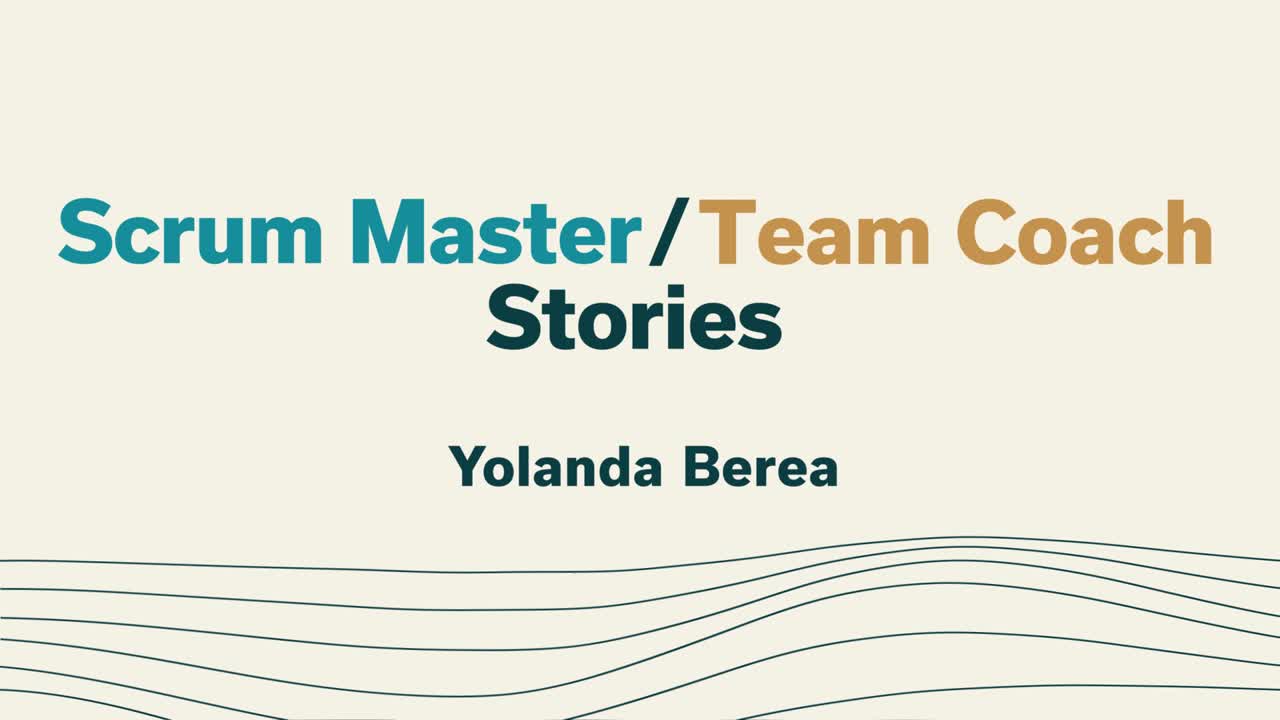
Details
Find a Course:
Implementing SAFe
Leading SAFe
SAFe for Teams
SAFe Scrum Master
SAFe Advanced Scrum Master
SAFe Product Owner / Product Manager
SAFe Release Train Engineer
SAFe DevOps
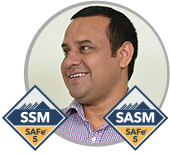
In SAFe, Scrum Masters assist their teams in meeting delivery goals. They coach teams in self-organization and self-management and help them coordinate and participate in Agile Release Trains (ARTs) events, increasing the effectiveness of SAFe across the organization.
SAFe Scrum Masters are integral members of an Agile Team and share responsibilities for the team’s overall performance.
Characteristics of a SAFe Scrum Master
The SAFe Scrum Master role has the primary responsibility to help the team achieve its goals. They do this by teaching and coaching SAFe ScrumXP and SAFe, implementing and supporting SAFe principles and practices, and identifying and eliminating bottlenecks to flow.
SAFe Scrum Masters come from various backgrounds and roles and are in high demand. But who makes a good Scrum Master? Although they are not typically people managers, they are influential members of an Agile Team. So, it’s important to know what characteristics make a good Scrum Master. For example, they often possess the following attributes:
- Empathetic. Supports the team by displaying an authentic understanding and concern for a team member’s beliefs or feelings. In turn, the team is more likely to build relationships with others, resulting in higher levels of collaboration and performance. Empathy is a key ingredient of trust, which is essential for people to accept and welcome coaching.
- Conflict Navigator. Supports team members in resolving interpersonal conflicts, problem-solving, and decision-making. Agile coach and author Lyssa Atkins opines, “Navigating conflict is our new mindset, in which we help teams move from conflict to constructive disagreement as a catapult to high performance.” [2]
- Servant Leader. Persuades, rather than use authority. As servant leaders, Scrum Masters focus on the needs of team members and those they serve with the goal of achieving results in line with the organization’s values, principles, and business objectives. [3]
- Mentor. Supports the personal development of team members, helping them gain a continuous learning mindset. They guide the team to find solutions to their problems independently instead of being given the answers.
- Transparent. Transparency is a Core Value of SAFe and one of the pillars of Scrum empiricism. The Scrum Master is open and appreciates transparency in others. They help the team provide transparency by ensuring artifacts are inspected, identifying significant differences between expected and actual results, and detecting anti-patterns.
- Coach. Understands and educates the team on methods beyond Scrum, such as SAFe, Team Kanban, Flow, Built-in Quality, and more. Helps build a high-performing team.
Responsibilities of the SAFe Scrum Master
The SAFe Scrum Master fulfills many critical responsibilities in performing the role, which is categorized in Figure 1. below. Each category is described in the sections that follow.
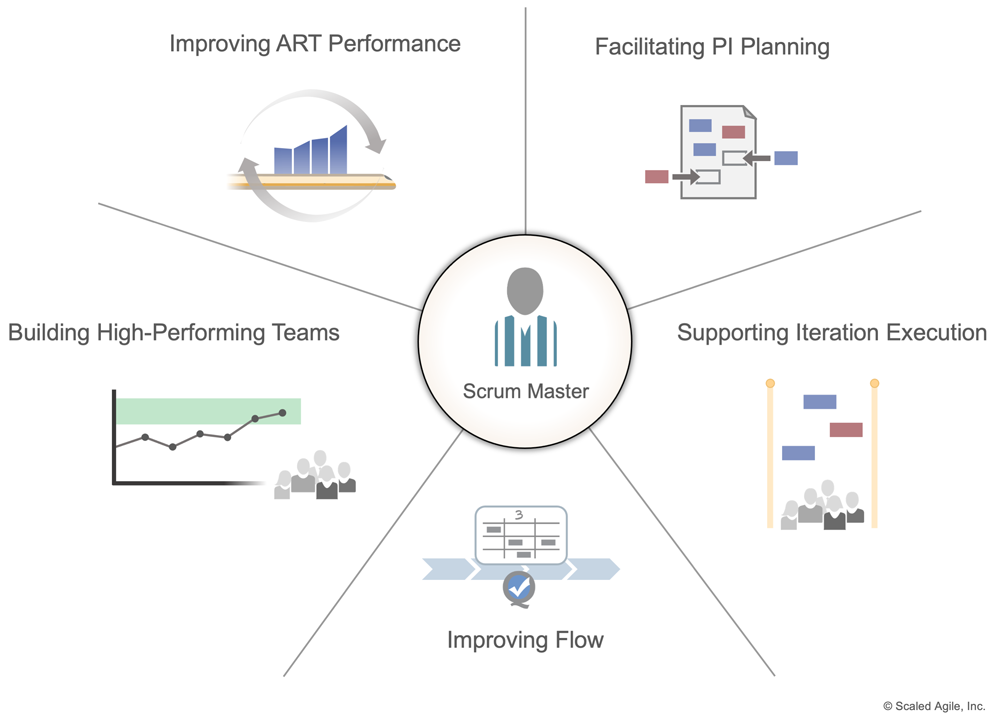
Facilitating PI Planning
SAFe Scrum Masters play an important role in PI Planning. Working with other Scrum Masters and the Release Train Engineer, they actively work with the team during PI planning to ensure a successful event.
Prepare for PI Planning
Before the event, the SAFe Scrum Master ensures the team is briefed on upcoming features by Product Managers, Business Owners, and other stakeholders, as illustrated in Figure 2. They help the team and the Product Owner identify local stories, maintenance, defects, tech debt, and other work the team needs to accomplish during the upcoming PI.
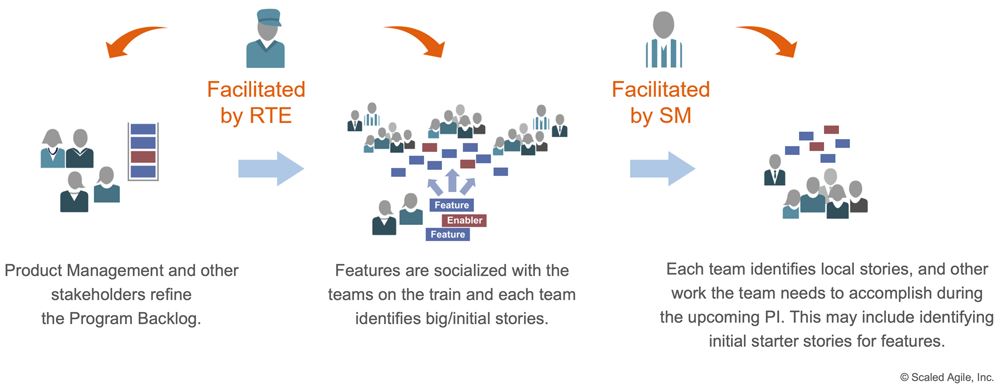
Draft PI Plans
The SAFe Scrum Master facilitates the team in creating a draft PI plan for the PI’s iterations, writing draft PI Objectives, and identifying program risks and issues. They also help the team set up their digital or physical planning areas, providing visual radiators that create transparency and collaboration. They help the team determine their capacity and keep within this constraint.
Coordinate With Other Teams
SAFe Scrum Masters often play a lead role in ensuring cooperation and communication during the event. During PI planning, they usually secure subject matter experts (SMEs) and program stakeholders and foster communication with other teams to determine how they will collaborate on feature development and resolve dependencies.
Create Team PI Objectives
SAFe Scrum Masters help teams create team PI Objectives, which are the things they intend to accomplish in the upcoming PI. They ensure the objectives are written before the draft plan review and that a proper mix of committed and uncommitted goals are present.
Review Final Plans and Business Value
Before the final review, SAFe Scrum Masters help ensure PI objectives are smart (Specific, Measurable, Achievable, Realistic, and Time-bound) and are written in a way everyone can understand. The Scrum Master often facilitates Business Owners and team collaboration during business value assignments.
Supporting Iteration Execution
SAFe Scrum Masters support the team during the iteration, increasing the team’s likelihood of achieving its iteration goals and PI objectives, as illustrated in Figure 3.
Facilitating Successful ScrumXP Events
Scrum events create the heartbeat of Scrum, and the SAFe Scrum Master has a critical role in determining the success of each, as illustrated in Figure 3.
Collaborating with the PO
Since the Product Owner is accountable for maximizing the value of the solution resulting from the team’s work, an essential aspect of the SAFe Scrum Master’s role is to support the PO as the team delivers value. They do this by:
- Helping the PO and the team understand and apply the tools and techniques for customer-centricity and design thinking to build the right thing at the right time.
- Ensuring the team understands the need for clear and concise team backlog items and aligns to the ARTs capacity allocation for each work item type.
- Helping the team apply empirical planning and development where progress is based on observation and experimentation of working solutions in small increments
- Facilitating collaboration with other stakeholders as needed
Improving Flow
Establish the Team Kanban Board
SAFe ScrumXP teams use Kanban systems to visualize the work and enhance flow. Implementing an effective Kanban system adapted to meet the needs of a specific Agile Team is based on the type of work performed (e.g., software development, marketing, hardware), the team members’ skills, and their role in the ART.
Establishing the Team Kanban system is best done by involving the entire team with the guidance and facilitation of an experienced coach. The SAFe extended guidance article, Applying Kanban in SAFe, describes how to establish a Kanban system as well as how the Kanban systems are connected in SAFe. Figure 4 below illustrates an example of a Team Kanban board.
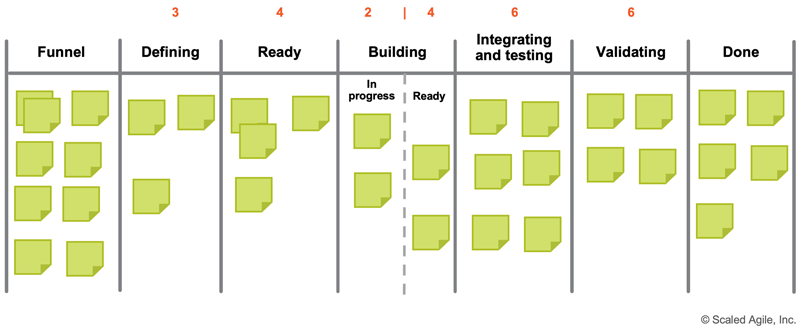
Measure and Optimize Flow
SAFe Scrum Masters help the team establish a system of metrics to assess and improve its overall performance. Specific measures for Flow, Competency, and Outcomes are described in Metrics.
Flow Metrics helps the Scrum Master and the team evolve its process iteratively and continuously adapt to fit the team’s needs. After defining the initial process and WIP limits and executing for a while, bottlenecks should become visible. If not, the team refines the process or further reduces some WIP limits until it becomes evident that a workflow state is overloaded or starving. Other coaching opportunities for optimizing flow might include merging or splitting steps, adding buffers, swim lanes and classes of service, or redefining workflow states.
Build Quality In
Agile Teams operate in a fast, flow-based system to quickly develop and release high-quality business capabilities instead of performing most testing at the end. The SAFe Scrum Master coaches Agile Teams to create and execute many tests early, often, and at multiple tiers. For example, unit tests are defined for code changes using Test-Driven Development (TDD), Behavior-Driven Development (BDD), and feature benefit hypothesis testing using Lean-UX are applied for Story, Feature, and Capability acceptance testing. Built-in Quality ensures that Agile development’s frequent changes do not introduce new errors and enables fast, reliable execution.
Building High-Performing Teams
Creating healthy Agile Teams is essential to creating high-value increments of working solutions. Fortunately, many of the ingredients for high-performing teams are built into SAFe by design. For example, Agile Teams in SAFe are small, cross-functional, and self-organizing. They are empowered to define and execute the work needed to accomplish the team’s objectives and those of the ART. Everyone agrees that all increments should meet a shared, scalable definition of done.
While every team is different, there are common characteristics that high-performing teams share. SAFe Scrum Masters are responsible for supporting and fostering the following team attributes:
- Self-management and taking ownership and accountability
- Aligned and collaborative
- Success focused on clear goals and purpose
- Effective decision-makers who understand their work’s impact on others
- Operate with open and transparent communication and trust
- Value diversity and healthy conflict
- Provide effective, timely feedback
- Highly engaged and have fun with work, and each other
Scrum Masters foster an environment for high-performing team dynamics, continuous flow, and relentless improvement. The Scrum Master mentors the team and creates an atmosphere of mutual respect, helping resolve interpersonal conflicts, and identifying growth opportunities. They assist the team in focusing on creating increments of high value for each iteration.
Become a More Effective SAFe Scrum Master
“Good leaders must first become good servants.” — Robert K. Greenleaf, father of servant leadership.
Every servant leader knows that their growth comes from facilitating the development of others who deliver the results. Scrum Masters serve the team and the larger organization.
The Scrum Master supports the overall adoption of SAFe across the enterprise by coaching stakeholders and non-agile teams on effective interactions with Agile Teams, participating in the Scrum Master Community of Practice, and supporting the organization’s SAFe Program Consultants (SPC).
As Lean-Agile leaders, SAFe Scrum Masters also advance the adoption of SAFe, leading by example and incorporating the Lean-Agile Mindset and SAFe principles into how they behave and perform their responsibilities, providing training and coaching, and being role models for others to follow.
Foster Collaboration on The Team
The SAFe Scrum Master role fosters more effective and cohesive teams, enabling better business outcomes, solutions, and products. They offer observations, feedback, guidance, and advice based on what they know and have seen work.
Coach with Powerful Questions
However, SAFe Scrum Masters do not have all the answers. Instead, they can ask powerful questions to uncover what’s essential, then guide others to tap into their knowledge and expertise. Some examples of powerful questions include:
- What brings us to this inquiry?
- What other possibilities or options exist?
- What is it we’re not seeing?
- What do we need to do to reach a deeper level of understanding?
- If success was guaranteed, what actions would you take?
By asking questions this way, Scrum Masters help teams improve their performance, solve more problems independently, make better decisions, learn new skills, and reach their goals.
Resolve Team Conflicts
Teamwork is the ultimate competitive advantage. However, many teams are dysfunctional, according to Patrick Lencioni, consultant and author of Five Dysfunctions of a Team. In his book, Lencioni suggests that an absence of trust leads to the other four dysfunctions. SAFe Scrum Masters help address these five dysfunctions with the SAFe practices illustrated in Figure 5.
Develop Team Skillsets
SAFe Scrum Masters work with team members and their functional managers to help them acquire T-shaped skills. A T-shaped individual has broad, general expertise in many areas and is an expert in one of these disciplines. They encourage team members to pair with others to expand their skills, take on tasks in another discipline and business domain, and participate in training courses and reading books to become continuous learners.
Improving Program Performance
SAFe Scrum Masters help teams improve the overall program performance through the following activities:
Facilitate Cross-Team Collaboration
Cross-team collaboration is a hallmark of high-performing teams. Agile Teams need to cooperate across departments to bring whole product solutions to market. SAFe Scrum Masters nurture an environment where cross-team collaboration thrives and is supported by practices that offer opportunities for teams to work together, for example:
- Alignment to PI objectives, Vision, and Strategic Themes during PI planning and addressing dependencies using the program board
- Representing the team in the Scrum of Scrums, PO, and ART Syncs
- Attending other team’s DSUs and demos with relevant team members
- Participating in ART’s System Demos and Inspect & Adapt events
One of the significant benefits of working on and across teams is colleagues learn from one another. On an Agile Team, learning new skills makes everyone more valuable to the organization and better equipped to support each other’s work. It also guards against specialty skills becoming a bottleneck, which increases delays and reduces quality.
Build Trust with Stakeholders
The SAFe Scrum Master helps the team build trust with stakeholders. SAFe relies on a rolling wave of short-term commitments from Agile Teams and ARTs to assist with business planning and outcomes, resulting in improved alignment and trust between development and business stakeholders. These are communicated via PI objectives. While solution development is uncertain by its very nature, the business depends on teams for some amount of reliable, predictable forecasting. Too little predictability and the business can’t plan. Too much, and the organization has committed to longer-term plans, which are unreliable and limit agility. Business and technology stakeholders need something in between, which is the primary purpose of PI objectives.
Finish the PI
The end of each PI is a busy time for SAFe Scrum Masters. They often perform the following types of activities:
- Coach the IP Iteration. Scrum Masters help ensure the team does not schedule any work for the IP iteration during PI planning. Instead, they coach teams to use the IP iteration as an estimating buffer for meeting PI objectives and providing dedicated time for innovation, continuing education, PI planning, and the Inspect and Adapt (I&A) events.
- Help the team Inspect and Adapt Ensure the team is prepared for the I&A event, including the PI System Demo, quantitative and qualitative measurement, and the retrospective and problem-solving workshop. They help guide the team in the I&A activities and stay within the allotted timeboxes.
- Facilitate the problem-solving workshop. Scrum Masters provide coaching in root cause analysis, the ‘five why’s,’ and Pareto analysis. They ensure that the relevant work needed to deliver the identified improvements is planned and added to the Team Backlog.
Full or Part-Time Role?
The SAFe Scrum Master can be a part-time or full-time role, depending on the size of the team, the context, and other responsibilities. However, it can be challenging at the Enterprise scale to justify the need for a full-time Scrum Master for each Agile Team. SAFe takes a pragmatic approach, a team member sometimes takes the position with other duties, or they can support more than one team. However, during initial SAFe adoption, the job can be more intensive. It’s often beneficial to hire external Scrum Master consultants to mentor the teams and help them become experienced in Scrum and SAFe. These consultants will work with multiple teams and new Scrum Masters in the organization. And of course, to be effective, adequate training and experience are required.
Learn More
[1] https://conversational-leadership.net/powerful-questions/ [2] https://medium.com/serious-scrum/scrum-master-as-conflict-navigator-de5c6a162fe [3] https://www.scrum.org/resources/blog/scrum-master-servant-leader#_ftnref7
Last Update: 17 August 2022





